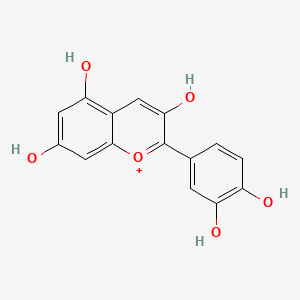| MeSH term | MeSH ID | Detail |
|---|---|---|
| Colonic Neoplasms | D003110 | 161 associated lipids |
| Edema | D004487 | 152 associated lipids |
| Glioma | D005910 | 112 associated lipids |
| Tooth Discoloration | D014075 | 7 associated lipids |
| Psoriasis | D011565 | 47 associated lipids |
| Wound Infection | D014946 | 12 associated lipids |
| Nerve Degeneration | D009410 | 53 associated lipids |
Cyanidin
Cyanidin is a lipid of Polyketides (PK) class. Cyanidin is associated with abnormalities such as Consumption-archaic term for TB, furuncle, Obesity, Cardiovascular Diseases and Endothelial dysfunction. The involved functions are known as anthocyanin biosynthetic process, Regulation, flavonoid biosynthetic process, Anabolism and anthocyanin metabolic process. Cyanidin often locates in Body tissue, integral to membrane, Autonomic nervous system, Blood and Tissue membrane. The associated genes with Cyanidin are anthocyanidin synthase, SLC2A8 gene, EPB41L2 gene, NKS1 gene and GLUCOSIDASE. The related lipids are Butanols. The related experimental models are Knock-out.
Cross Reference
Introduction
To understand associated biological information of Cyanidin, we collected biological information of abnormalities, associated pathways, cellular/molecular locations, biological functions, related genes/proteins, lipids and common seen animal/experimental models with organized paragraphs from literatures.
What diseases are associated with Cyanidin?
Cyanidin is suspected in Obesity, Chronic Disease, Diabetes Mellitus, Non-Insulin-Dependent, Cardiovascular Diseases, Heart Diseases, Inflammatory disorder and other diseases in descending order of the highest number of associated sentences.
Related references are mostly published in these journals:
| Disease | Cross reference | Weighted score | Related literature |
|---|
Possible diseases from mapped MeSH terms on references
We collected disease MeSH terms mapped to the references associated with Cyanidin
PubChem Associated disorders and diseases
What pathways are associated with Cyanidin
There are no associated biomedical information in the current reference collection.
PubChem Biomolecular Interactions and Pathways
Link to PubChem Biomolecular Interactions and PathwaysWhat cellular locations are associated with Cyanidin?
Visualization in cellular structure
Associated locations are in red color. Not associated locations are in black.
Related references are published most in these journals:
| Location | Cross reference | Weighted score | Related literatures |
|---|
What functions are associated with Cyanidin?
Related references are published most in these journals:
| Function | Cross reference | Weighted score | Related literatures |
|---|
What lipids are associated with Cyanidin?
Related references are published most in these journals:
| Lipid concept | Cross reference | Weighted score | Related literatures |
|---|
What genes are associated with Cyanidin?
Related references are published most in these journals:
| Gene | Cross reference | Weighted score | Related literatures |
|---|
What common seen animal models are associated with Cyanidin?
Knock-out
Knock-out are used in the study 'MATE2 mediates vacuolar sequestration of flavonoid glycosides and glycoside malonates in Medicago truncatula.' (Zhao J et al., 2011) and Knock-out are used in the study 'How can research on plants contribute to promoting human health?' (Martin C et al., 2011).
Disease model
Disease model are used in the study 'How can research on plants contribute to promoting human health?' (Martin C et al., 2011).
Animal Disease Models
Animal Disease Models are used in the study 'How can research on plants contribute to promoting human health?' (Martin C et al., 2011).
Related references are published most in these journals:
| Model | Cross reference | Weighted score | Related literatures |
|---|
NCBI Entrez Crosslinks
All references with Cyanidin
Download all related citations| Authors | Title | Published | Journal | PubMed Link |
|---|---|---|---|---|
| pmid: | ||||
| Wang H et al. | Antioxidant and antiinflammatory activities of anthocyanins and their aglycon, cyanidin, from tart cherries. | 1999 | J. Nat. Prod. | pmid:10075763 |
| Redus M et al. | Rate and equilibrium constants for the dehydration and deprotonation reactions of some monoacylated and glycosylated cyanidin derivatives. | 1999 | J. Agric. Food Chem. | pmid:10552670 |
| Terahara N et al. | Anthocyanins from red flower tea (Benibana-cha), Camellia sinensis. | 2001 | Phytochemistry | pmid:11249101 |
| Tanaka M et al. | A malonylated anthocyanin and flavonols in blue Meconopsis flowers. | 2001 | Phytochemistry | pmid:11249104 |
| Meiers S et al. | The anthocyanidins cyanidin and delphinidin are potent inhibitors of the epidermal growth-factor receptor. | 2001 | J. Agric. Food Chem. | pmid:11262056 |
| Matsui T et al. | alpha-Glucosidase inhibitory action of natural acylated anthocyanins. 2. alpha-Glucosidase inhibition by isolated acylated anthocyanins. | 2001 | J. Agric. Food Chem. | pmid:11308352 |
| Matsumoto H et al. | Preparative-scale isolation of four anthocyanin components of black currant (Ribes nigrum L.) fruits. | 2001 | J. Agric. Food Chem. | pmid:11312893 |
| Matsumoto H et al. | Orally administered delphinidin 3-rutinoside and cyanidin 3-rutinoside are directly absorbed in rats and humans and appear in the blood as the intact forms. | 2001 | J. Agric. Food Chem. | pmid:11312894 |
| Nakajima J et al. | Reaction mechanism from leucoanthocyanidin to anthocyanidin 3-glucoside, a key reaction for coloring in anthocyanin biosynthesis. | 2001 | J. Biol. Chem. | pmid:11316805 |
